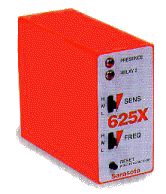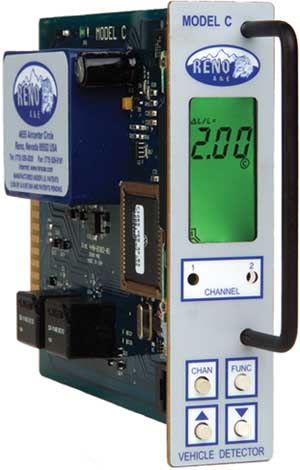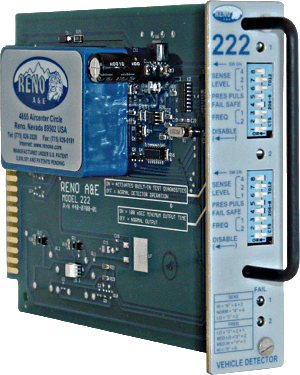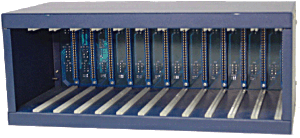| Author | Message | ||
Tomzweifel |
Does anybody else have problems triggering the loop sensor under the pavement at traffic lights, or is it just me???? | ||
Ronlv |
yes i just wait untill its suposed to turn green and run the red | ||
Typeone |
I hate this too! I think most bikes have this issue, just too damn tiny. I've had to blow red lights (without a soul in sight mind you) just to get on my way... no cagers around to help trigger it from across the intersection  (Message edited by typeone on May 01, 2005) | ||
Tommy_2stroke |
Yeah, you'd think that big steel can way down under would be plenty enough metal mass to do it, but nope. Some signals just have the threshold set too high. Although *sometimes* it helps to place the bike dead center in the loop in the pavement. | ||
1313 |
http://www.greenlightstuff.com/trigger.html | ||
Blackxb9 |
Some lights can also be triggered by blowing your horn. Try it and you will be amazed. I learned that in my MSF class a few years back. | ||
Metalstorm |
http://www.signalsorcerer.com/home.html is another one. I'm assuming it's ok to give link since none of our sponsors carry this. (note to admin, if I'm wrong please delete and accept my appology) The only problem I see is where would you mount it?? There's a big muffler below the bike right where the signal device would go on any other bike. It could maybe go on the swingarm but then it wouldn't be over the loop at the stoplight where it should be. For those who may not know, the loop is the wires in the asphalt that detects the vehicle and triggers the light. | ||
Oldbueller |
In over 2 years with my 9R, I've never had a problem. I also learned something at a MSF class 20+ years ago: Be sure to stop with something steel (like the XB muffler) over the loop in the pavement. Look for a roughly 2" diamond shape cut in the pavement. | ||
Oldbueller |
Oops. Not a 2" diamond. Try a 2' diamond. | ||
Evaddave |
If you can see where the loop is, put your kickstand down on it. | ||
Cmm213 |
I used to work on traffic and lighting a few years back, I'm in indiana we cut octagon shapes, but the wire in the cuts usually goes around the octagon several times then a layer of foam rope is stuffed in, then they are sealed with tar or a gray rubber sealer. How well they work depends on how new or old they are and how deep they were put in, all varies. I used to have problems too on my gxrs. I wont get started on the whole camera issue, if they dont get aimed right the intersection will be a nightmare. Not to mention fog and snow! my 2cents | ||
Eor |
I overheard two policeman talking this morning. Apparently our state legislature has passed a law addressing this. Supposedly, a motorcycle can now proceed through an intersection if the stop signal is malfunctioning...assuming that the rider has stopped and it is safe to do so. One of the officers asked, "How will the motorcyclist know if the signal is truly not working and how will an officer know that a motorcyclist isn't just running a stoplight and using the new law as an excuse? As for the first part...I guess if you sit through a couple of rotations and never get a green, you can assume you aren't triggering it. As to the second...I dunno...  This may be one of those instances in which the solution causes more havoc than the initial problem. It's not like we aren't at enough of a disadvantage at intersections already.  | ||
Gearheart |
Get one of the small neodymium magnets the ones that are strong as all hell and put in on the oil drain plug on the bottom of the engine or even better the bottom of the muffler. Then you will promptly and reliably trip the lights. | ||
Tatsu |
Jump off... push the pedestrian cross walk button jump back on. | ||
Gschuette |
Back in Tennessee you can stop look both ways and if no one is coming proceed with caution. Might want to just be careful and wait if you see a cop but it is legal. I think the law took effect at the start of 04. I don't know how many other states are like that. | ||
Captainkirk |
On most "problem lights", once properly identified, if you back up the bike the reposition it over the FORWARD LEFT SIDE of the loop it'll trigger. There are always those ones that defy anything other than a D8 caterpillar though. Once identified, I simply avoid them (I have two in my county like that) | ||
Diablobrian |
The horn changing it is a myth,  ok more like an obsolete piece of knowlege, based on when the police/ambulance sirens changed them. ok more like an obsolete piece of knowlege, based on when the police/ambulance sirens changed them. A strobe light does that in most places now. Go to your local hardware store. Find the magnets. Pick the largest/strongest that you can stash in your belly pan and some epoxy (or gorilla glue). Epoxy the magnet in place. You will now trigger red lights for less than any commercially available trigger. (Message edited by diablobrian on May 02, 2005) | ||
Eor |
Wouldn't a very strong magnet act to pull even more nails and other metallic trash under your wheels?  | ||
Court |
>>>>A strobe light does that in most places now. It is doen with a 3M Opti-Com system. There are two levels, one for "routine" traffic such as buses the other for "emergency" vehicles. Depending on if you are using a NEMA (like the Eagle 7000) or a Type 70 (running WKS software) the Opti-Com (techincally known as a pre-emption device) calls a subroutine that takes the controlled "short way" to the next possible green through a series of MUTCD compliant phases. The "loops" are inductive loops, tuned in Micro Henries, with the exception of Micro-Probes (another 3M product) which measure magnetic distrubance in Oerstad's rather than simple phase shift in a resonance circuit. The "gray goo" is a one part fixotropic ploymer used to cover, generally 3 turns, of #14 XHHW or IMSA "Detecta-Duct" looptube. Loops, both dipole (you'll see these long, usually 6' x 50', in places like Overland Park, KS and Addison, TX and they can be indentified by the 3 parallel cuts which effectively make the loop "hotter" in the center and cuase the pattern to "pull in" at each side to minimize adjacent lane calls (don't want the straight lane, summoning a left turn arrow). These loops are most sensitive right smack dab down the middle. For our friends in California, you'll see what appear to be 5' diamter circles that are cut with what appears to be a hufe hole saw. They're cut about 1" deep, get the 3 turns and are sealed. CalTrans (you can see the detector lab I built for them at I-5 and Del Paso Road in Sacramento) seems to prefer these. Long and short of it is that the "loops" are tuned to various frequencies to prevent "false" and adjacent lane calls. There are instancs, stretches and delays, where I *WANT* a loop to forget you are there...say you pull up, activate the loop, then make a legal right turn. In this case, I'd program, say 3 seconds in the delay. The loop would process the initial call and the, after the delay, come back and see if you are still there. If you are, then the call goes to the microprocessor to get things under way to handle the call. In the case of a "strecth" I may have the left turn lane (119th and Metcalf in OPK and Josey Lane in Carrollton, TX come to mind) set to process an intial green of 3 seconds and then "add 1.5 seconds for each 2 cars within 5 second windows up to a max (called Force Off) of 15 seconds. Anyway.... Here are some typical loop sensors, a an articel about how to handle them on motorcycles and some technical information.     Court | ||
Tommy_2stroke |
So with all that electronics, presumably the trigger threshold is adjustable, right? It would seem simple enough at the time the sensor is installed for the tech to make sure that the system triggers with one "bike mass" of metal in the detector field. Dear Caltrans: I hereby volunteer me and my XB as a calibration tool. I will ride around California this summer and help set up traffic signals. You have to buy me cheeseburgers, coffee and Buell fuel. Heh... | ||
Jeremyh |
i just go to the far right side of the turn lane. most of out intersections here in boise have an independant sensor mounted atop the turn signal lights and points down to the far right hand side of the turn lane. | ||
Court |
Constraint is picking up lopw flying aircraft.... Court (who spent a summer in a modified Ford SHO testing HSWIM (High Speed Weigh-in-Motion) systems under the scutiny of the Federal Hwy Dept SHRP (Strategic Highway Research Program) There is nothing cooler than having the highway patrol close the road whilst you blast an SHO at a set of load cells. Now you know where the strobes came from in my lights. | ||
Oneway |
cant count how many lights i've ran | ||
Bomber |
I spoke with a locacl LEO about this kinda thing on Saturday -- it was fixed sometime before this AM -- wow, local gubmint that responds -- I think I'd better go lay down | ||
Jeremyh |
the only problem i have with running the lights that don't work for me is that when i get back in my car it is still stuck in my head to turn left on red when no one is around. | ||
Jaredkuper |
A friend of mine puts a magnet from an old computer hard drive on the underside of his bike. Swears it works like a charm, but I haven't tried it yet. | ||
Charlieboy6649 |
Jared, Yes the free kind are the best kind... | ||
Steve_mackay |
I have about 3 routes I can take to work. Every route, I *HAVE* to run a red if I go in to work before 6AM light. If I go to work after 6AM, it's not a problem, since usually there is enough traffic to trip the lights. | ||
Pcmodeler |
I know that Virginia law states you can run the red after either the 2nd or 3rd red cycle. | ||
Kaese |
I live in a gated community that has the sensor to open the gate on the way out. Some guy on a scooter complained and they were able to increase the sensitivity. I assume that traffic light can be adjusted the same way. I was under the impression that they were pressure sensitive and have had good luck compressing the front forks while on the on the front strip. Guess I am wrong. | ||
Dr_greg |
Try being a cyclist (pushbike)...them things NEVER trigger! Hmm, maybe the magnet is worth a try. | ||
Court |
>>>>I was under the impression that they were pressure sensitive Years ago, prior to the use of inductive loop detectors, pressure treadles, actually a very primative load cell, we widely used. The trend now is toward non-invasive detection with things linke sonar, radar, and my personal favorite, video. Years ago, from a hotel room in Wichita, KS, I experiented with using a cursor to define (basically just draw) "detection zones" on a screen and then link phase calls to them. It's come a long way. Court | ||
Duff24 |
I don't know...after reading some of the different methods of "vehicle detection" at stoplights, a truck that's jacked up 5 feet off the ground would not be detected because it's so far away from the pavement. Would this be correct based on the explanation? I know these things can be adjusted, it's just a matter of these idiots programming them! | ||
Static |
Don't forget what lives between the tires and the suspension of the truck. At least one, typically rear, Iron axle housing that I assure you cannot be more than 20 or so inches off the ground. | ||
Charlieboy6649 |
Yea, that's a lot of axle down there... http://www.badweatherbikers.com/buell/messages/17143/105336.jpg | ||
Tomzweifel |
I just talked to my county's engineering department. I had a list together, they know of part of the problem. At many of the lights around here, with two lanes in each direction, the loops run across both lanes. The key is either to stop to the left track of the left lane, or the right track of the right lane. In any event, as others have said, stop on the outside edge of the loop and you're in business. I tried it at a couple of "problem" intersections already, works like a charm. Go figure. | ||
Metalstorm |
Yep, the corners of the loop are best as there's more wire, therefore better sensitivity. When I'm paving jobs that are inside private gates, I'm always having to smack the gate loop on the corner with the backside of a square point shovel to open the gate for the truck drivers who don't know the gate code. |